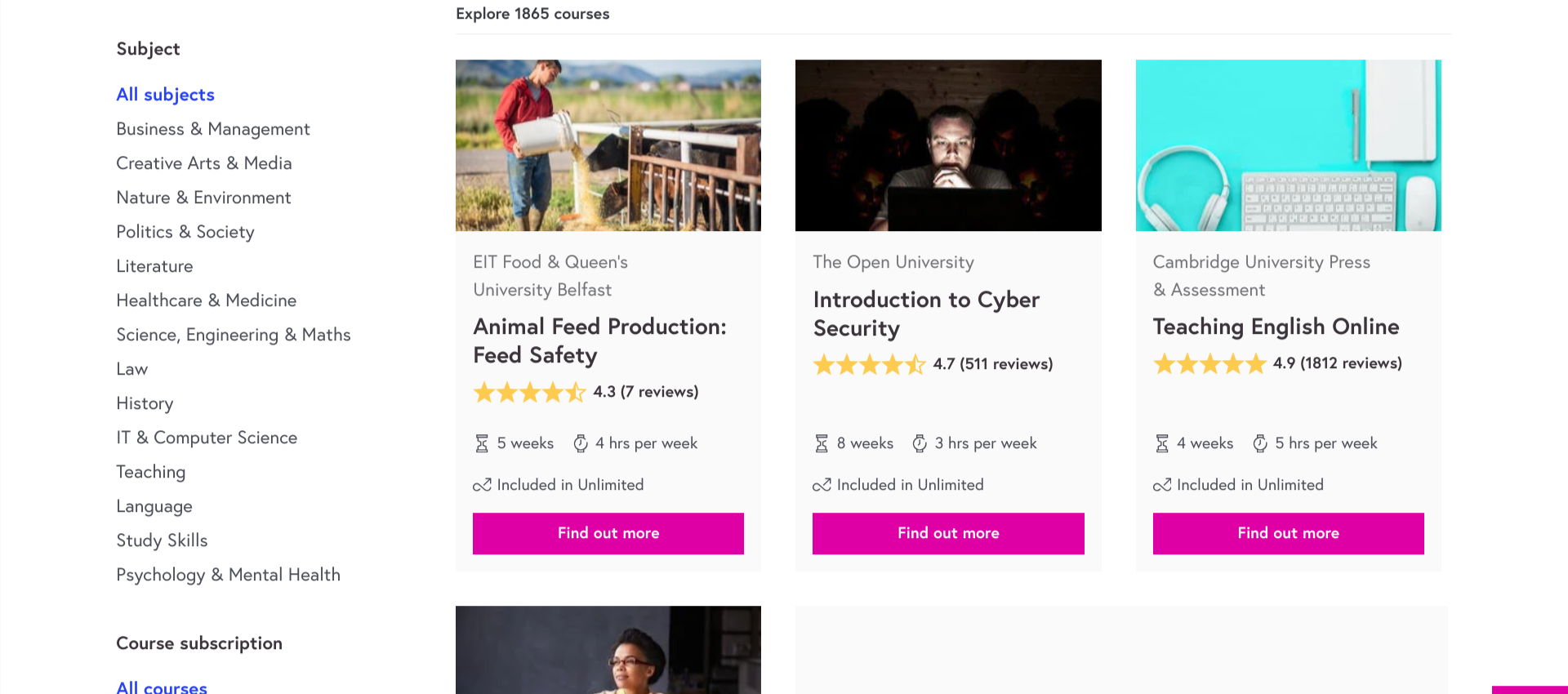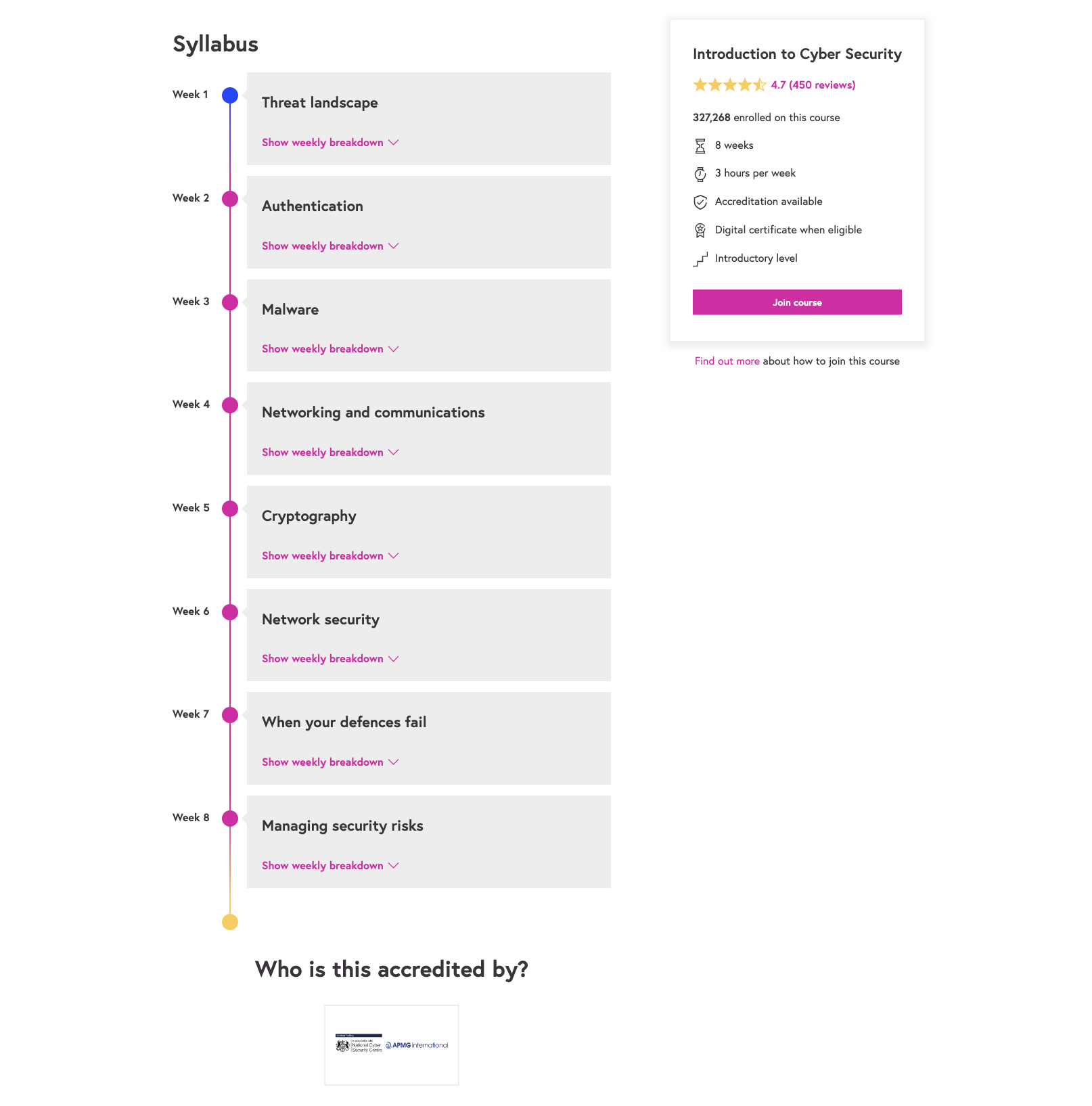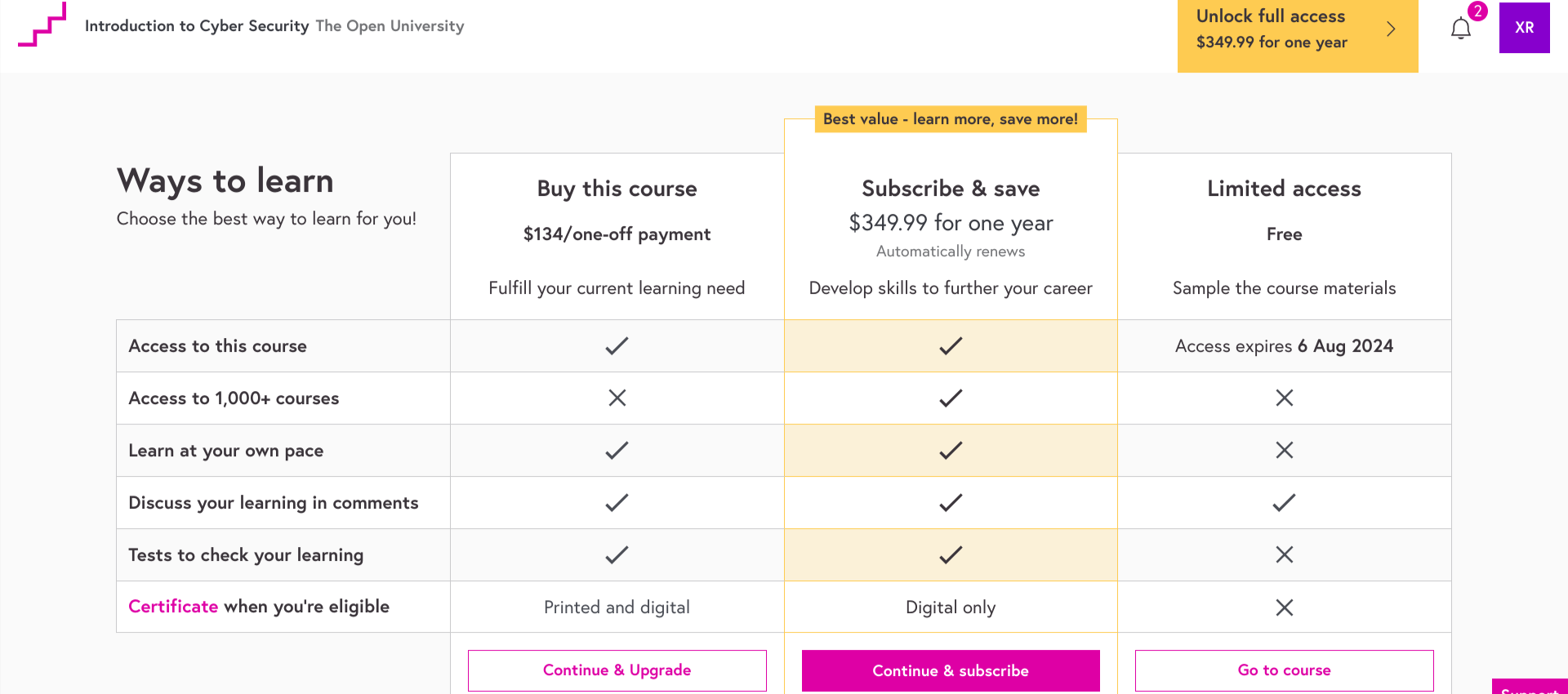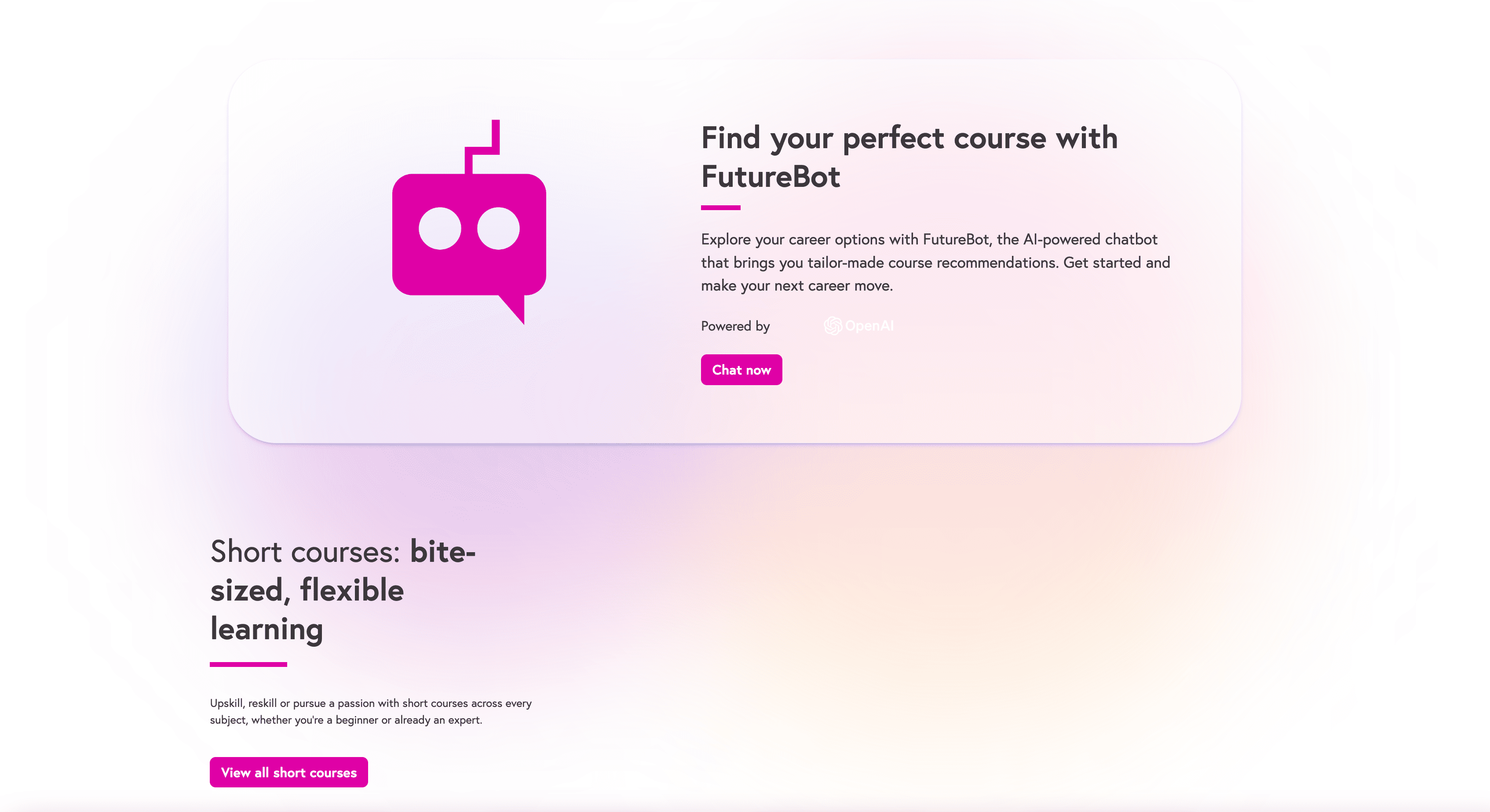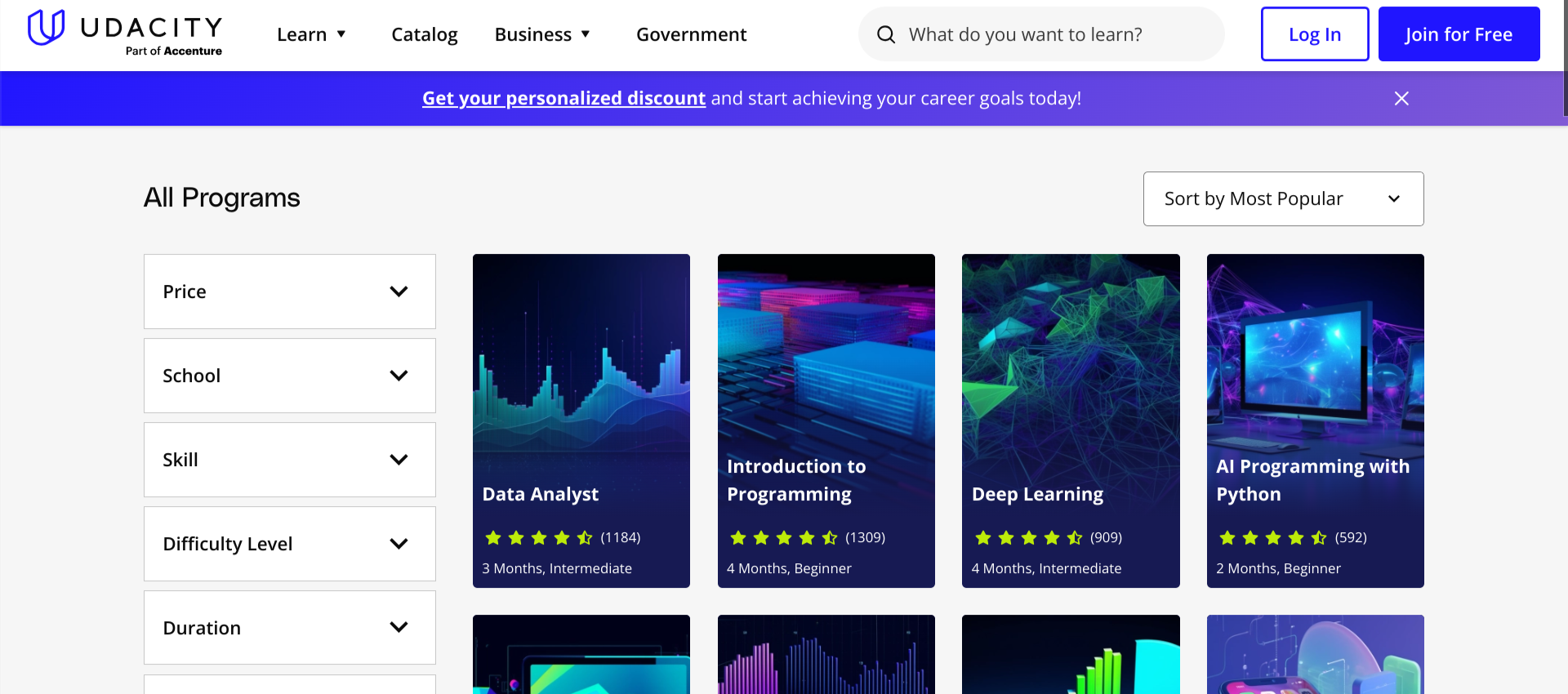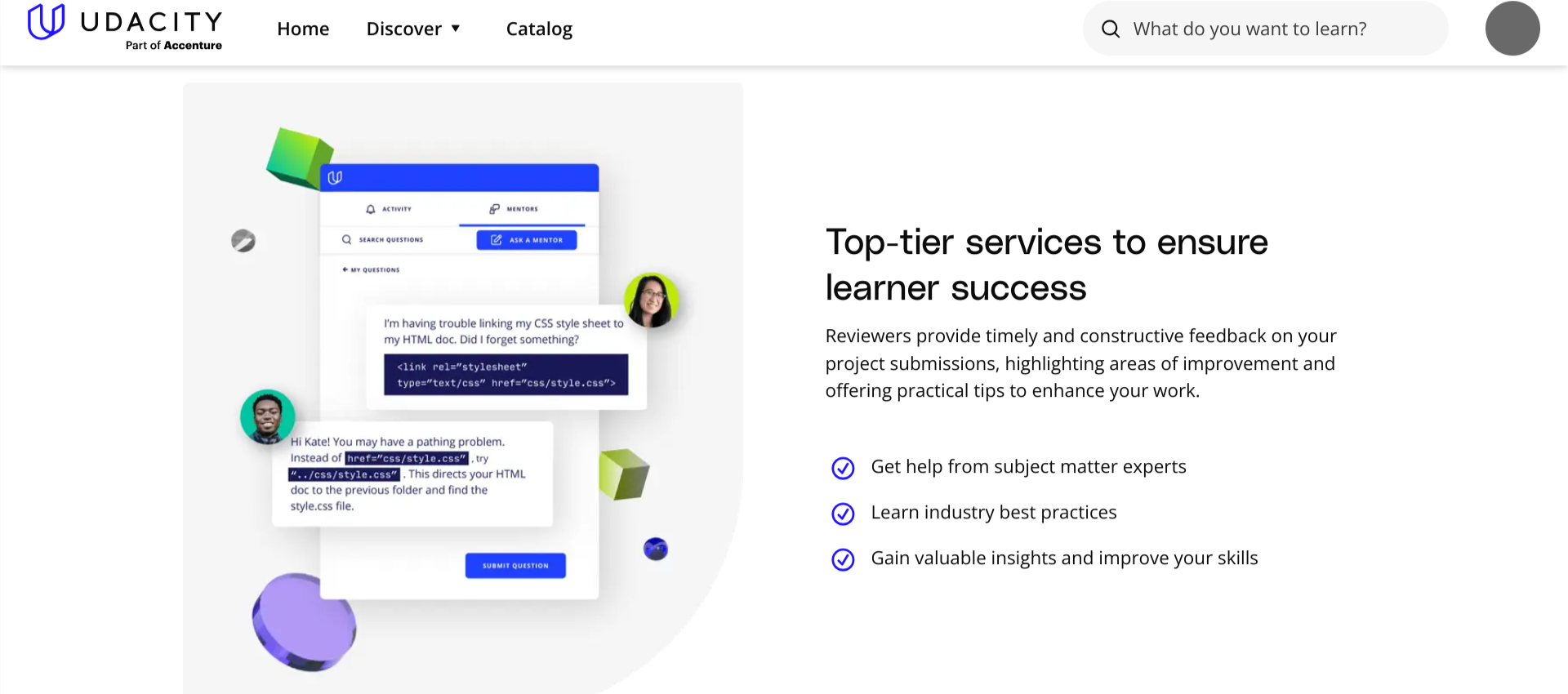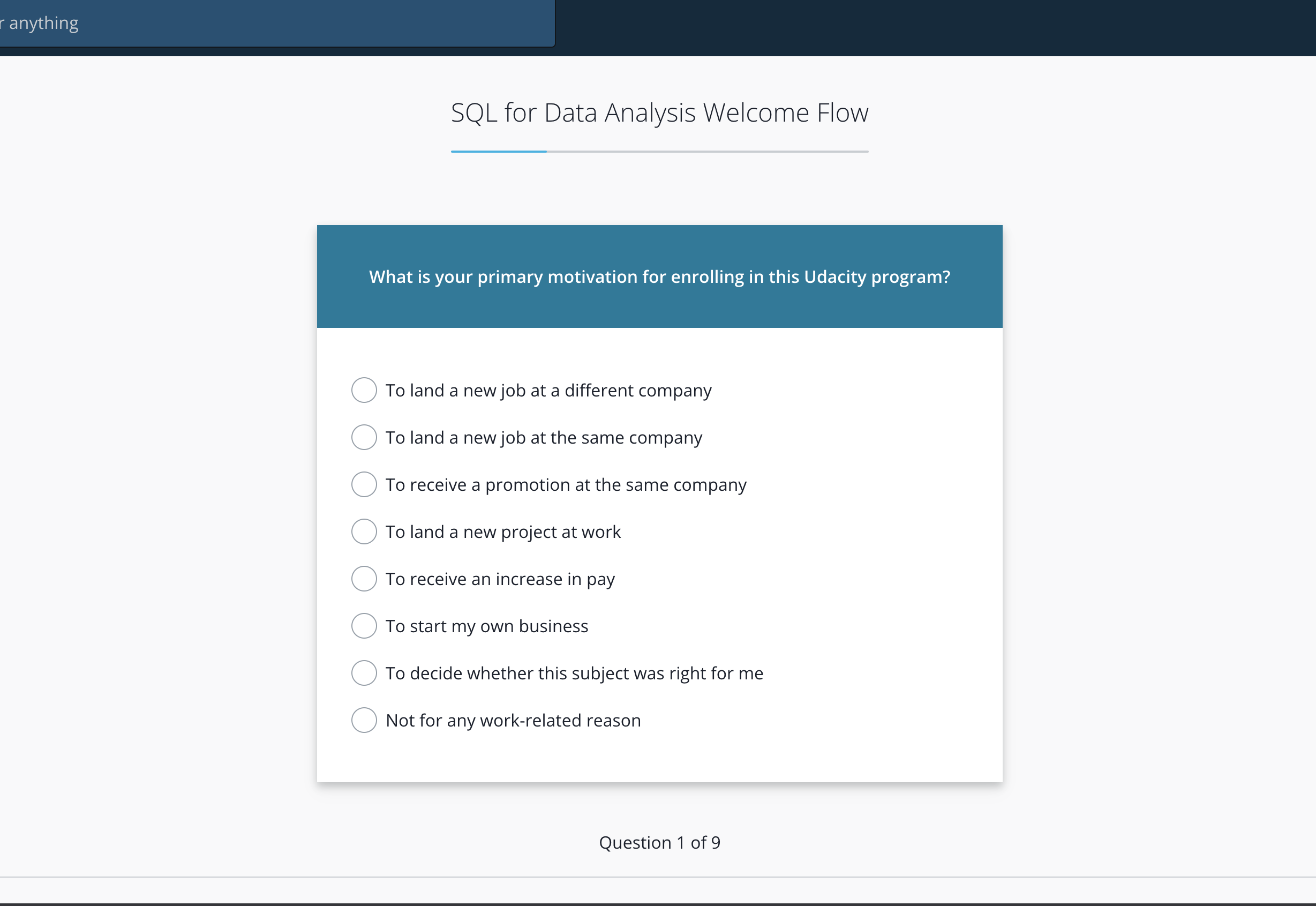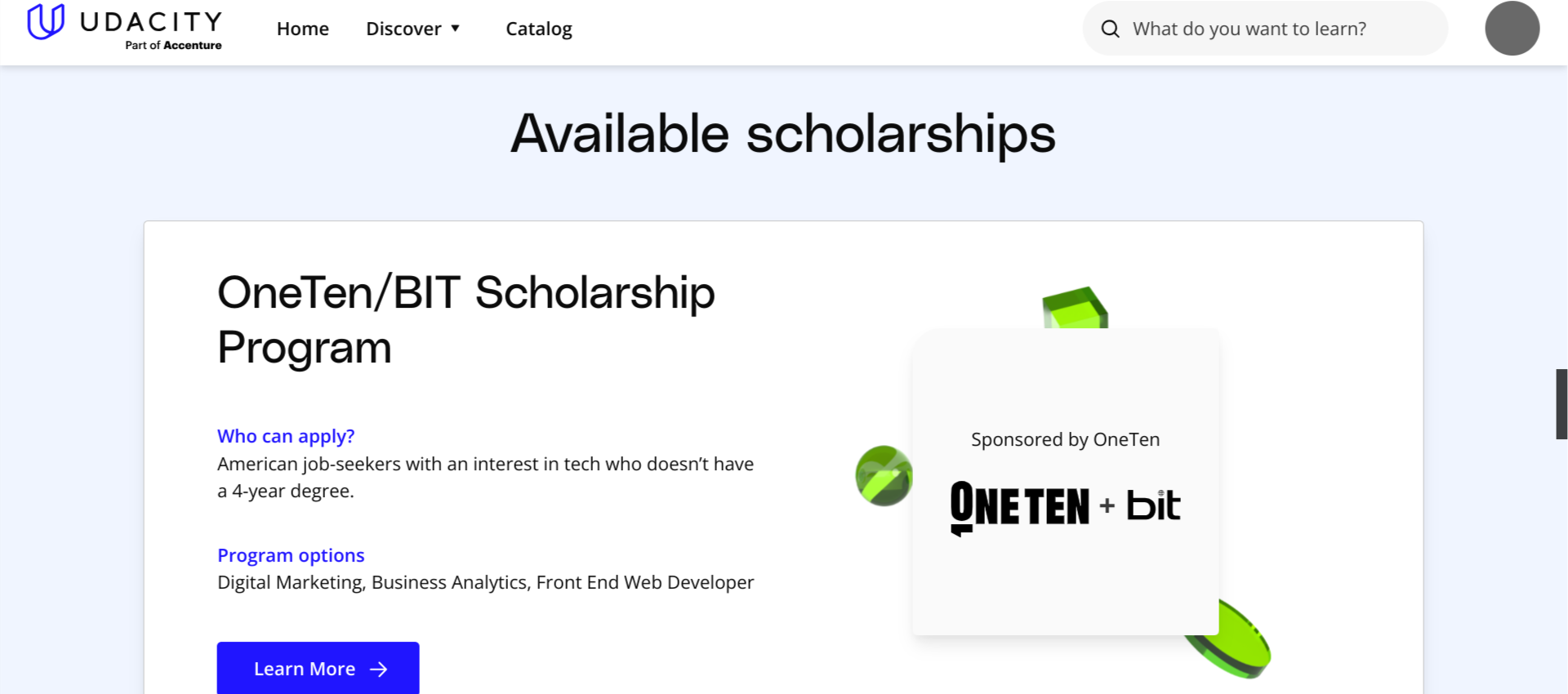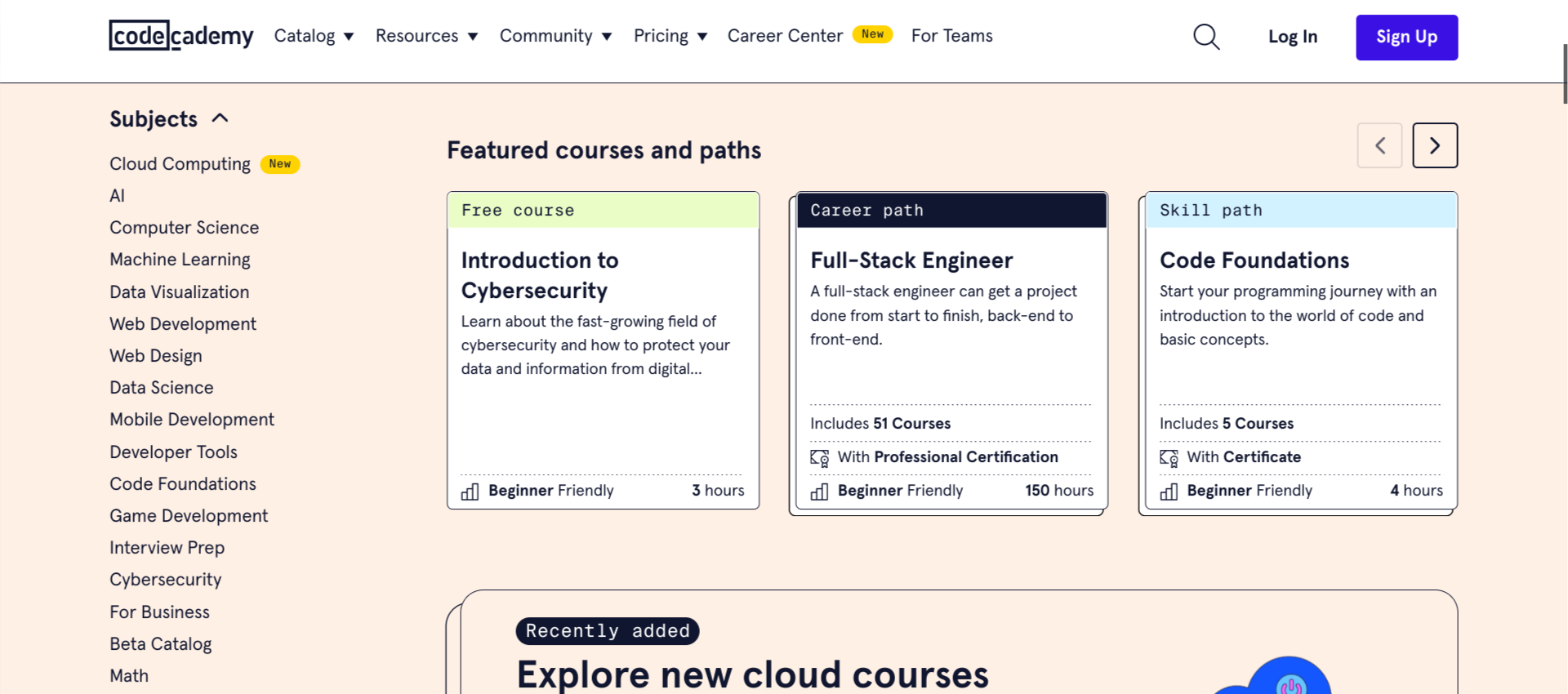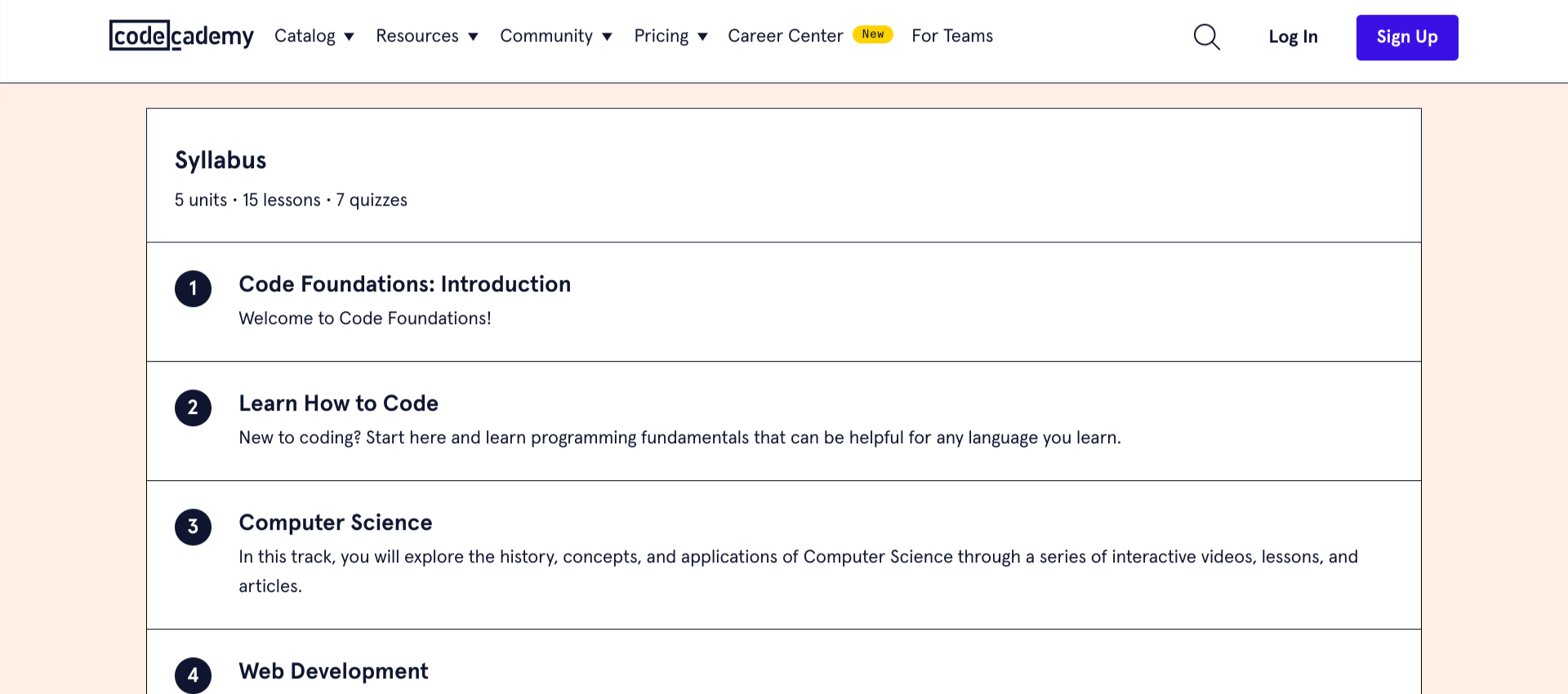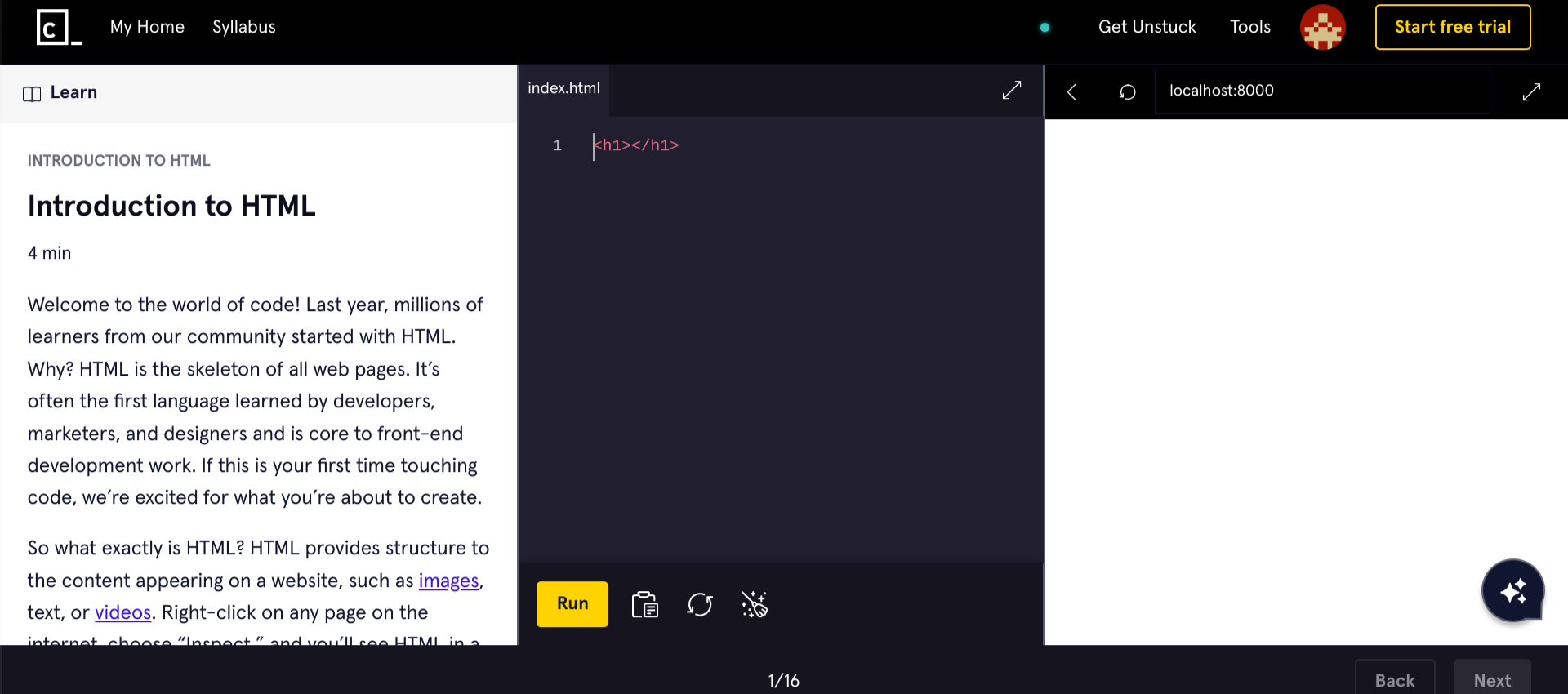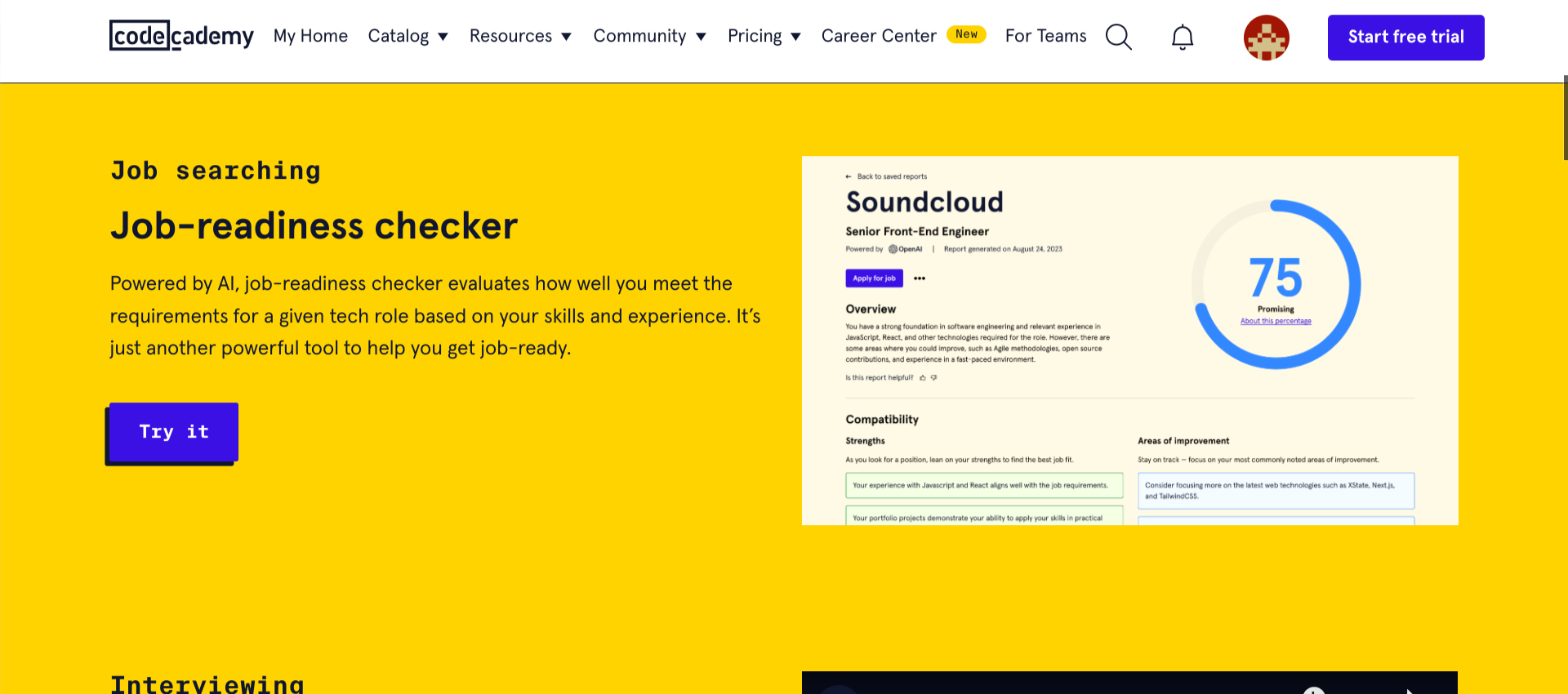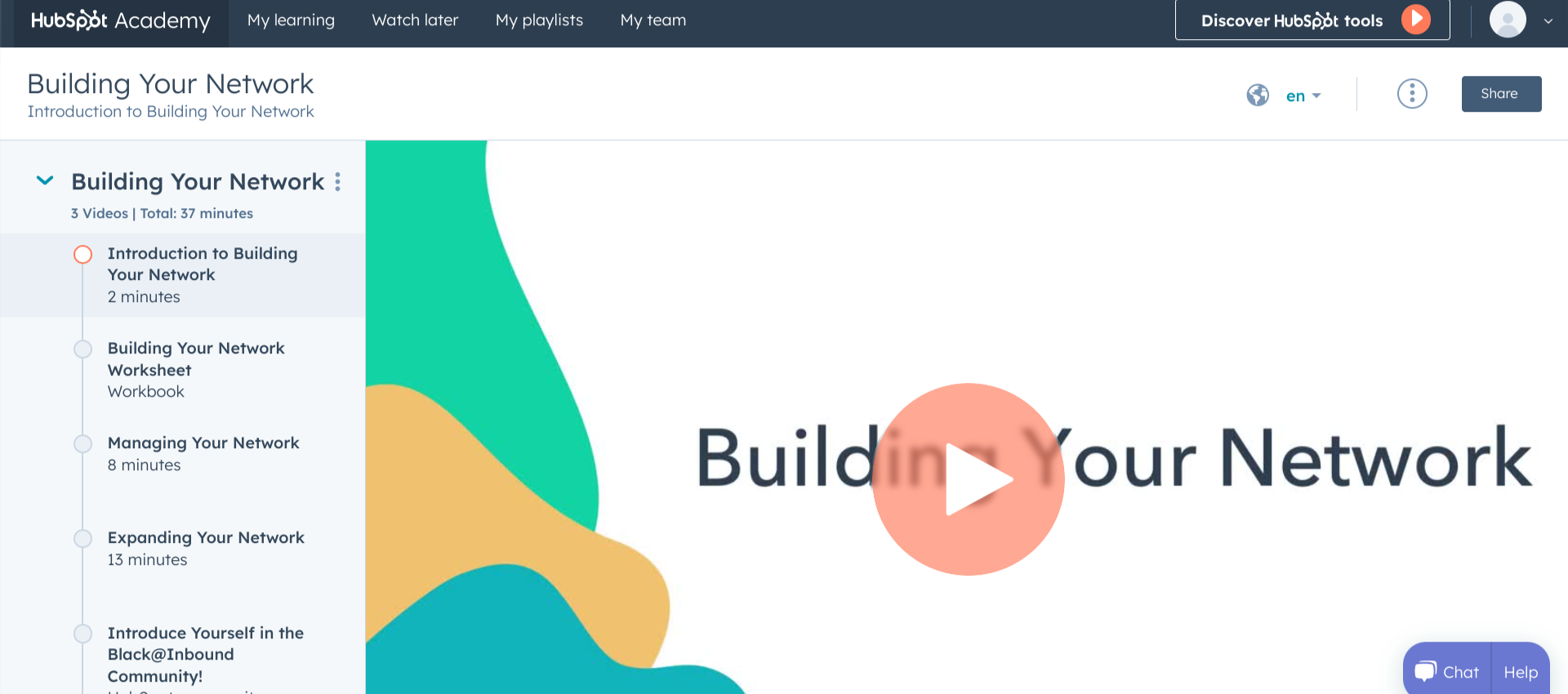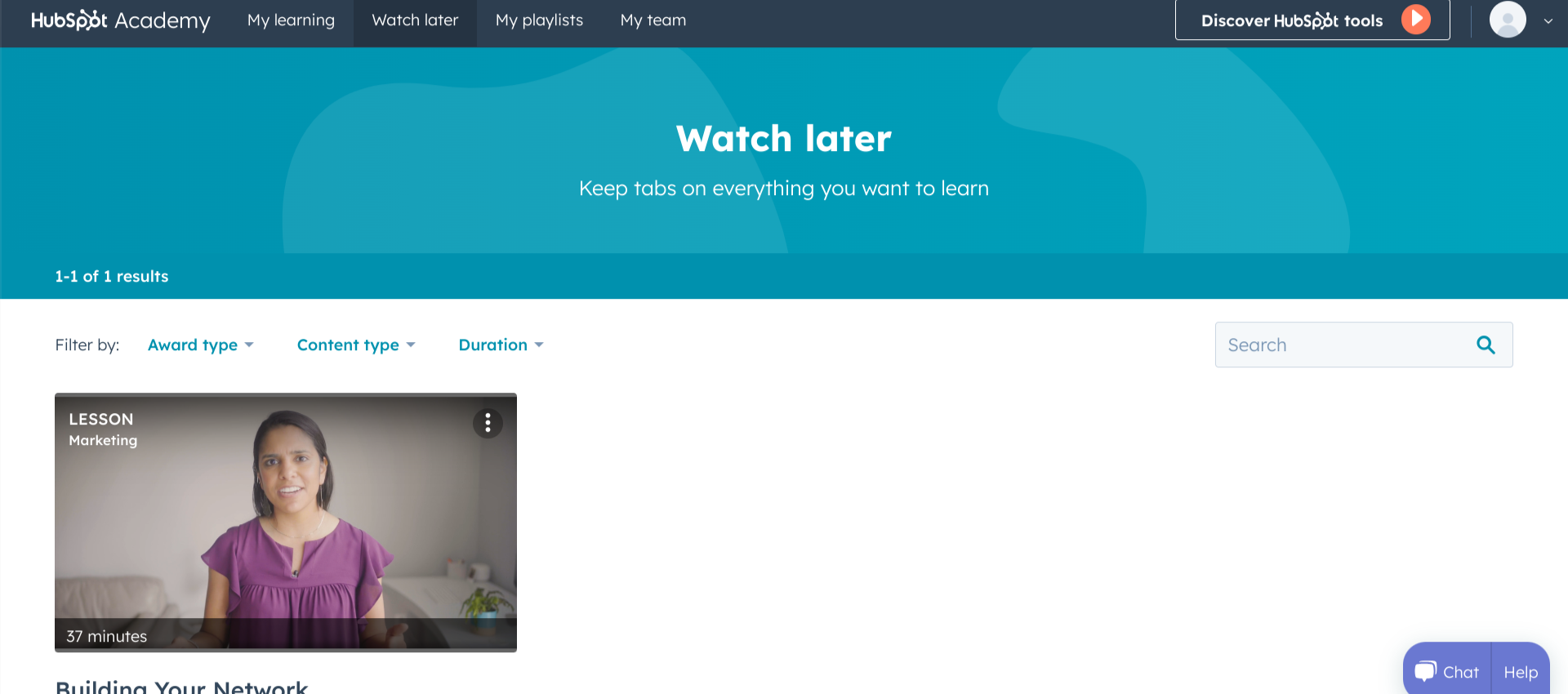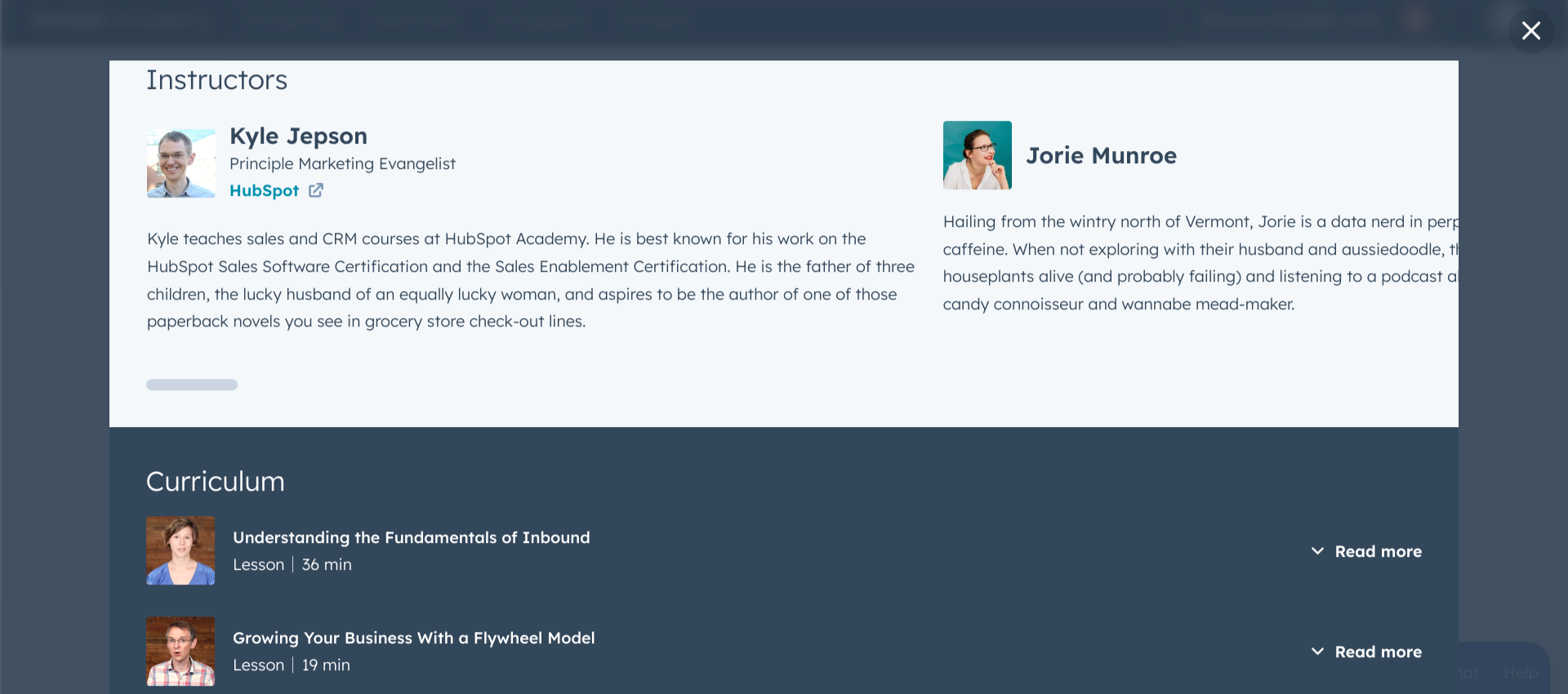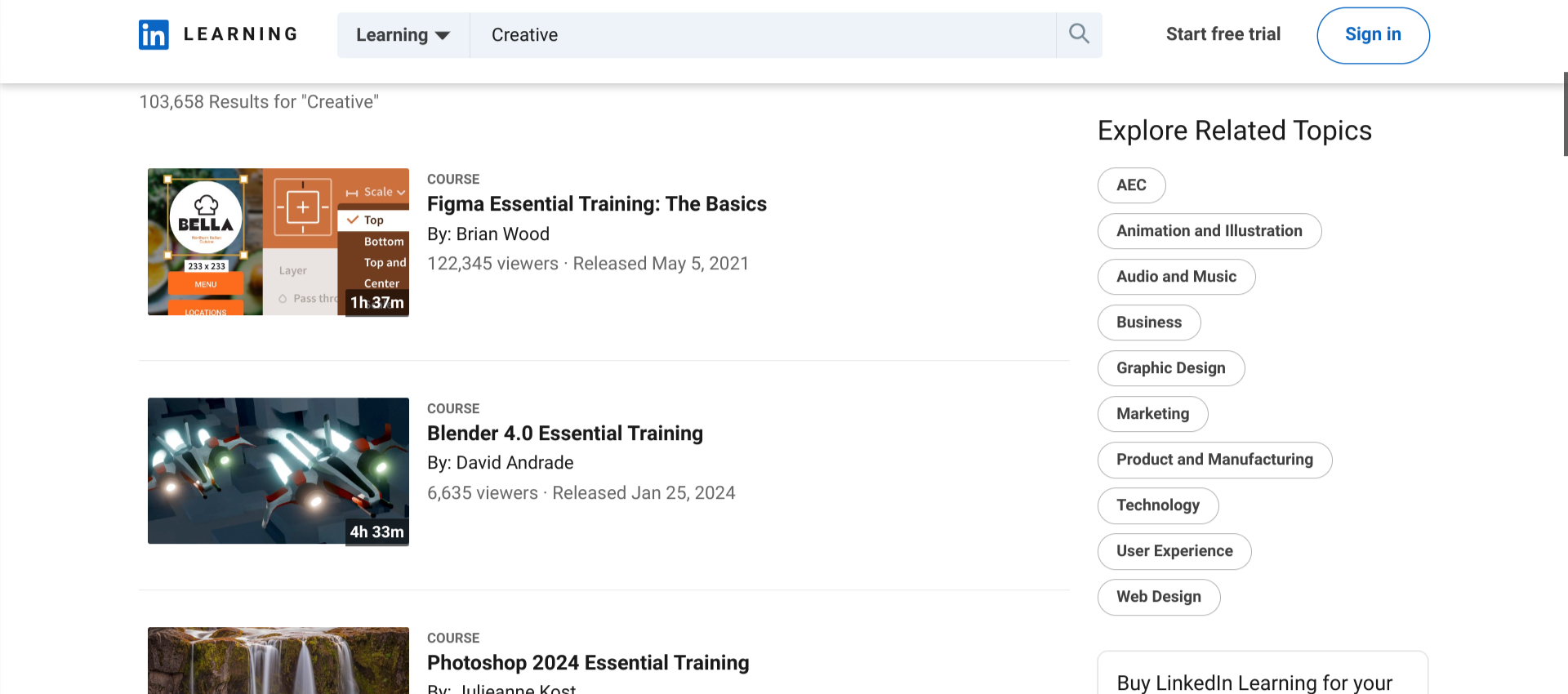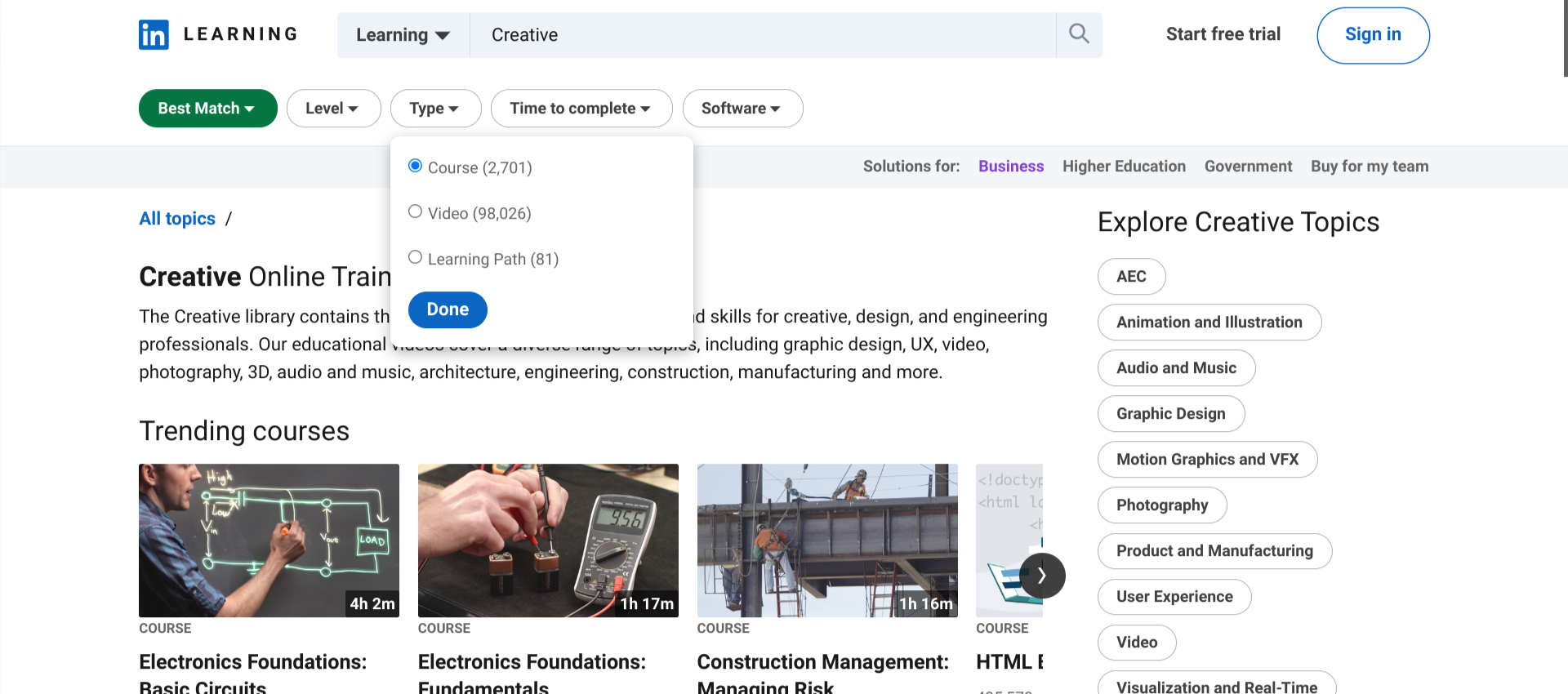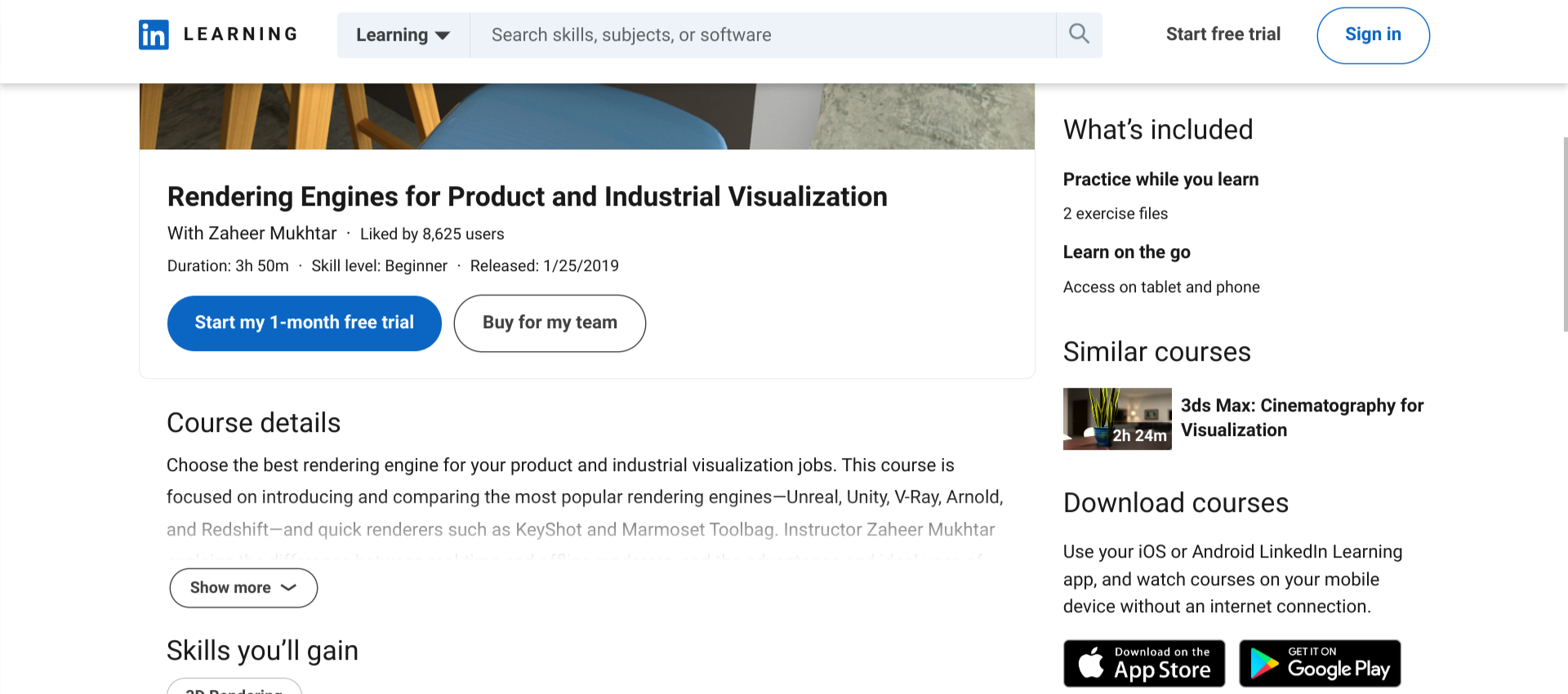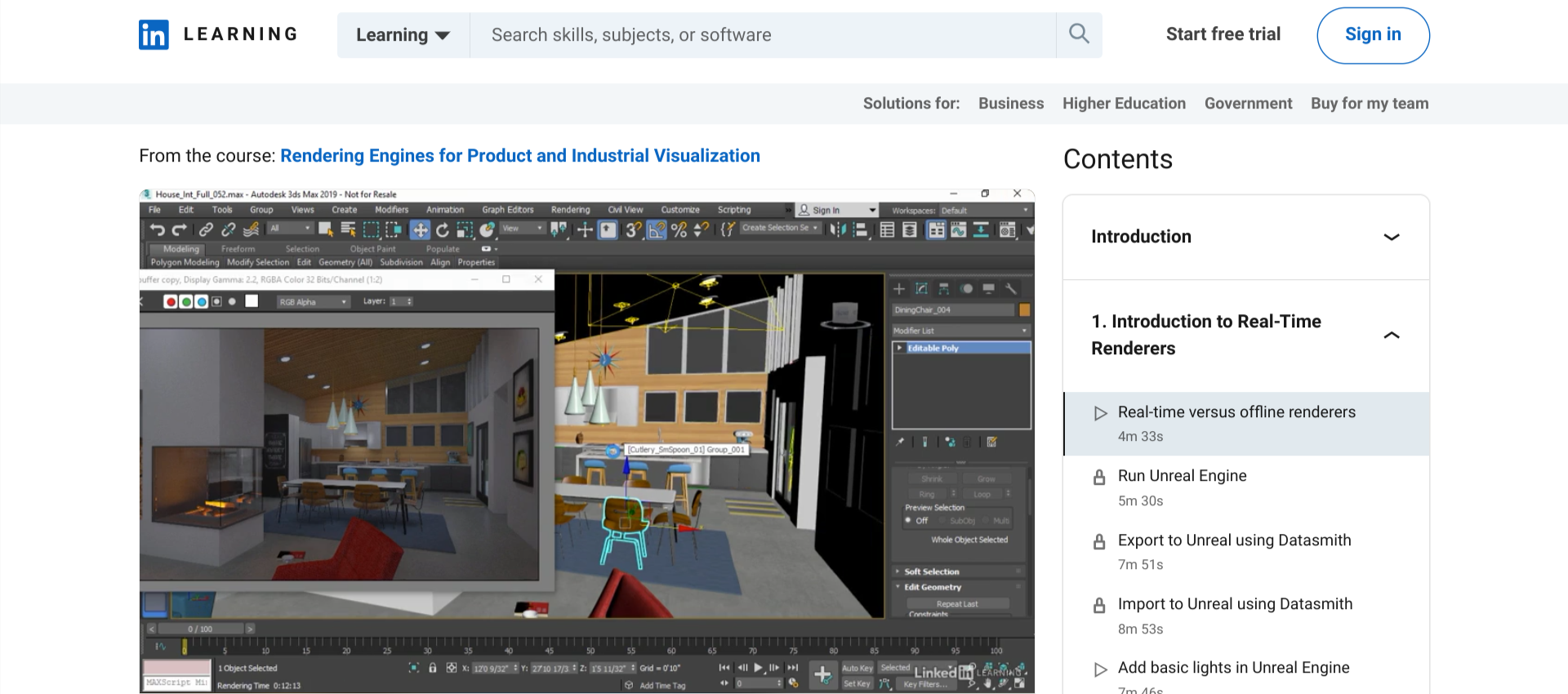Higher education is changing, with students questioning the value of a traditional degree or finding that they need to learn new skills to keep up with changing technologies. Many students are turning to online courses (also known as Massive Open Online Courses, or MOOCs) as a cost-effective, flexible way to gain new knowledge, start a different career path, or explore an area of interest.
With so many platforms offering online courses, it can take a lot of work to know which ones are actually worth your time and money, so we created this list of the best online course providers. In updating our research, we found that several popular platforms, including EdX, Coursera, and Udemy, have experienced a decline in the quality of course offerings, customer service, and user experience, resulting in their removal from this list.
Top 5 Online Course Providers
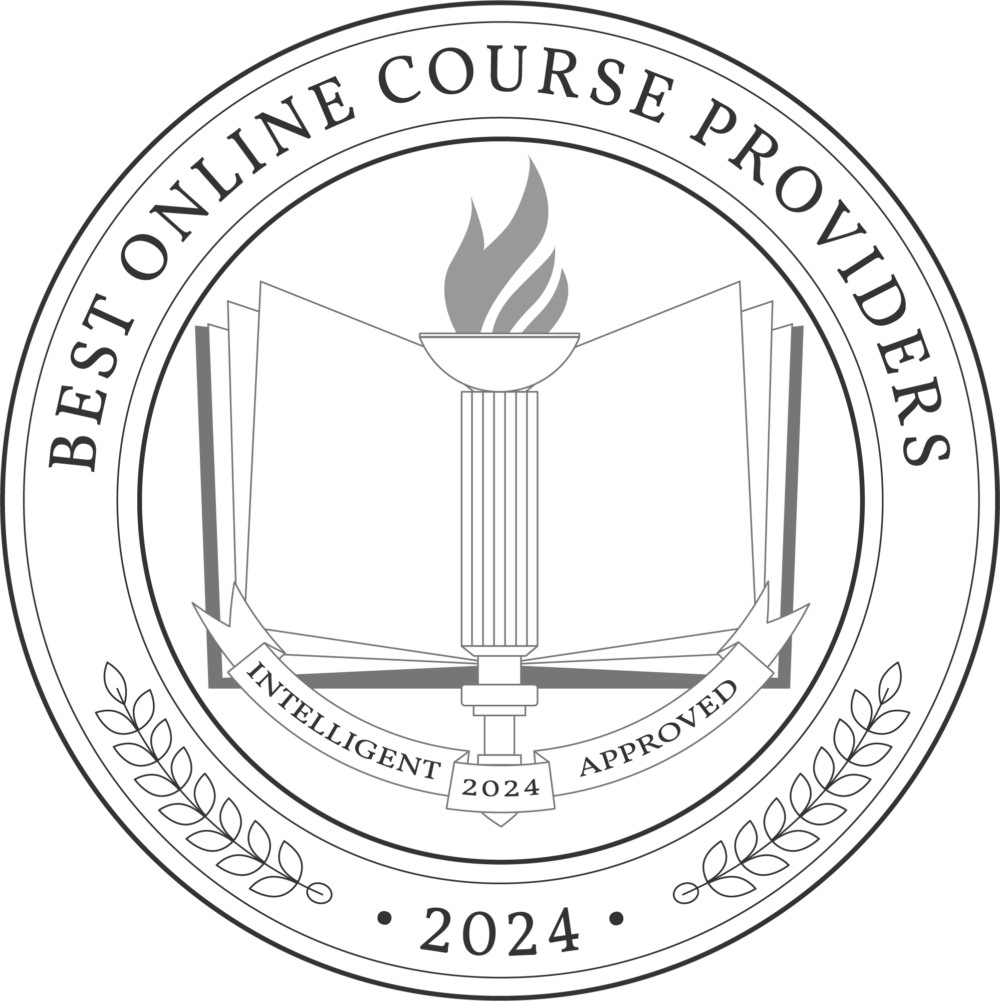
- FutureLearn – Best for Accelerated Courses
- Udacity – Best for IT Courses
- Codecademy – Best for Coding Courses
- HubSpot Academy – Best for Marketing Courses
- LinkedIn Learning – Best for Creative Courses
How We Chose the Best Online Course Providers
We evaluated over a dozen popular online course providers to find the best ones, creating a list of top-quality educational platforms that can help students achieve their professional and personal goals.
We dug deep into online course providers, reviewing their websites, course catalogs, sample lessons and study materials, and reviews from third-party sites such as Trustpilot, G2, and Facebook Reviews. Online course providers were evaluated based on four key criteria:
Course offerings
Online courses attract a diverse student population, and we wanted to ensure that the providers on our list cater to a wide variety of needs. We considered what providers offer in terms of areas of study, course levels (beginner, intermediate, advanced), and what program options are available (individual courses, degrees, certificates). Even providers that focus on more niche areas, like Codecademy, give students plenty of opportunities for different skills within their respective fields. Our goal was to recommend providers that can give students enough options to choose from without becoming overwhelming.
Cost
Another appealing aspect of these online course providers is that they typically have free and paid options that cost significantly less than traditional two- or four-year degree programs. Depending on the provider, students can pay per course or sign up for a subscription plan that gives them access to unlimited courses. To ensure that students are still getting their money’s worth, we compared what providers offer in terms of course materials, length of access, course completion documentation, and more to guarantee that students are getting the skills, knowledge, and support they deserve.
Also, before sharing credit card information with an online course provider, students should carefully review all available information about pricing, terms, and cancellation policies. Several providers were eliminated from our list for overcharging students or poor business practices that made it difficult for users to cancel their subscriptions.
Student satisfaction
With so many online courses available, a single organization can’t test them all. That’s why we turned to students who have completed courses with these companies to hear what they had to say about their experiences. We scoured platforms like Reddit, Trustpilot, G2, and others for user reviews on their experiences with these providers, including the quality of the education they received and their interactions with faculty and customer support. Providers like EdX and Udemy which had consistently low student satisfaction ratings, based on course quality, customer support, and deceptive business practices, were removed from this year’s list.
Faculty and course developers
We also reviewed who designs and teaches the courses students take through these online providers. Several, like edX and Coursera, aggregate courses from the world’s top universities, like MIT, University of Toronto, Kyoto University, and more, giving students access to renowned faculty. Other providers, like Codecademy, partner with industry-leading companies to create courses focused on in-demand skills across a variety of industries. However, since faculty vetting processes vary by provider, prospective students should always conduct their own research into a course instructor to ensure they have the proper expertise and experience in their area before enrolling in a course.
Top 5 Online Course Providers
FutureLearn – Best for Accelerated Courses
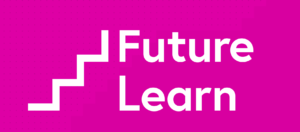
FutureLearn is a UK-based online learning platform that gives students access to MOOCs, microcredentials, online degrees, and professional certification programs. Their organization is based on the values of social learning, empowerment, transformation, and experimentation. Through FutureLearn, students can access a catalog of courses from top universities, global companies, and professional organizations. Their ExpertTrack and microcredential programs offer students an efficient way to upskill and gain valuable new knowledge quickly.
| FutureLearn Overview | |
| Types of available programs |
|
| Areas of study | 14 subjects available |
| Course level | Advanced |
| Number of courses | 1,865 |
| Cost | Short courses: $39.99 per month (or $349.99 per year) for full access
Microcredentials: $300 to $1,700 Online degrees: $10,000+ |
| Available languages | Most courses in English |
What We Like
We chose FutureLearn as our pick for best accelerated courses for the variety of options they give students who are looking to gain new skills and credentials in as short a time as possible.
Students seeking an individual class can choose one of FutureLearn’s short courses, which take 2-8 weeks to complete. ExpertTracks group together classes so students can deep-dive into a particular topic and earn a professional certificate in as little as six weeks. Microcredentials are another way FutureLearn helps students accelerate their education. Many microcredential courses are accredited, meaning students can apply them to traditional degree-granting programs.
We also like the FutureLearn gives students a variety of options for paying for their courses, including monthly or annual subscriptions. With an unlimited subscription, students can choose as many courses as they want from the platform’s library of classes in 14 different subject areas, including IT and computer science, language, law, business and management, literature, and more.
What We Didn’t Like
FutureLearn’s website is somewhat challenging to navigate, with users having to search out FAQs and Help pages to find key information, like the cost of subscriptions and FutureLearn’s educational partners. Searching for this information could be a turn-off for some users, who may seek platforms that make important information easier to find. They also need to allow prospective students an option to filter courses by level, which would be helpful.
What Students Are Saying
FutureLearn users give the platform a 4.6-star rating on G2, and a 4.7-star rating on Trustpilot. Satisfied users like that FutureLearn offers them an opportunity to learn from leading universities around the world and that their video lessons are short, straightforward, and easy to understand.
Udacity – Best for IT Courses

Udacity was the brainchild of Stanford University instructors who wanted to make tech education more accessible for students regardless of their location. They offer a number of popular, skill-based programs that prepare students for careers as data scientists, programmers, business analysts, UX designers, and more. By specializing in IT content, Udacity is able to provide high-quality courses designed and taught by tech industry leaders and landed itself as our recommendation for the best online IT course provider. Udacity was acquired by the consulting firm Accenture in March 2024.
| Udacity Overview | |
| Types of available programs |
|
| Areas of study | 10 subjects available |
| Course level | Beginner, intermediate, advanced |
| Number of courses | 300 |
| Cost | Full catalog access: $249 per month |
| Available languages | 8 language options |
What We Like
Udacity’s catalog features free and paid courses that cover multiple areas within the IT field. Some of their classes are exclusive to the platform, including programs in artificial intelligence, self-driving car engineering, and robotics software. The platform partners with international companies like GitHub, and Microsoft, for curriculum design and instruction, guaranteeing students learn the most cutting-edge information, innovations, and skills.
The centerpiece of Udacity’s offerings is their nanodegree programs, most of which can be completed in 3-5 months of online classes and coursework. Nanodegrees allow students to deep-dive into a specific topic, providing them with the foundational, intermediate, or advanced skills they need to start a new career or advance in their current fields. Udacity supports students with flexible classes, career services resources, and mentorship support.
Udacity creates a customized experience for students by having them complete a short questionnaire upon registering, which the platform uses to recommend courses to help students meet their goals.
What We Didn’t Like
Udacity’s focus on IT-related courses and programs may be a plus to some, but it also limits the platform’s audience to students interested in that particular field. Students should also be aware that some nanodegree programs may take several months to complete. This is longer than some of the accelerated courses other providers offer, so individuals should consider how much time they have to devote to their studies.
What Students Are Saying:
Udacity has a 4.9-star rating on Facebook Reviews, 4.5 stars on Trustpilot, and 4.5 stars on G2. As one reviewer noted, “The program is tailored for every learner type. Those who are biased towards a self-paced learning approach will be satisfied by the classrooms and reference links they offer.”
Codecademy – Best for Coding Courses

Leading SAAS company Skillsoft created Codecademy to help students learn computer programming, one of the tech industry’s most in-demand skills. This online course provider allows students to learn coding basics for free and also offers a number of professional development programs that include in-depth lessons and practice, career coaching, and certificates of completion. Through Codecademy, students can learn all the in-demand coding languages, including Python, Java, JavaScript, PHP, Ruby, Swift, and more.
| Codecademy Overview | |
| Types of available programs |
|
| Areas of study | 22 subjects available |
| Course level | Beginner, intermediate |
| Number of courses | 570 |
| Cost | Basic: Free
Plus: $29.99 per month or $179.88 per year Pro: $39.99 per month or $239.88 per year |
| Available languages | English only |
What We Like
Whether students are new to coding or looking to deepen existing knowledge, Codecademy is a great place to start. This online learning platform offers individual programming language classes at the beginner and intermediate levels. Most classes are available for free, although students will need to upgrade to a paid plan to access all of a course’s features, including projects, assessments, and certificates of completion.
For students who choose to pay, Codecademy offers two subscription plans – Plus, which is ideal for students who want to focus on skill-building, and Pro, which features curated learning paths and career guidance to help students obtain jobs as engineers, developers, data scientists, and more. Plus plans are $179.88 annually, and Pro plans are $239.88, making Codecademy an affordable option for many seeking additional skills or a new career.
We also like Codeacademy’s on-demand delivery format. Classes take anywhere from one to 30 hours to complete, and learning is done through reading assignments and hands-on practice.
What We Didn’t Like
Codeacademy is best suited for independent, self-motivated students who like to learn by reading and doing. The classes don’t include any kind of video or audio component, which may make completing the courses more difficult for students who learn better by listening or watching demonstrations of concepts. Additionally, Codeacademy’s free courses are somewhat limited, as students must pay for a Plus or Pro plan for access to graded assignments and experiential learning projects.
What Students Are Saying
Codecademy students give the platform 4.6 stars on Facebook Reviews and 3.4 stars on Trustpilot. Positive reviews include this one, saying “Lessons and projects have all been relevant and well-structured. The learning community on discord has been supportive and very helpful. It’s been the most fun and challenging experience I’ve had in a long time.”
HubSpot Academy – Best for Marketing Courses

Since its founding in 2006, HubSpot has become a leader in developing software for sales, customer service, and inbound marketing. With HubSpot Academy, their online education platform, they’re looking to help the next generation of marketing, sales, and development professionals access the training they need to pursue fulfilling careers. We recommend HubSpot Academy for students seeking online marketing and sales courses for their affordability and industry expertise.
| HubSpot Academy Overview | |
| Types of available programs |
|
| Areas of study | 6 subjects available |
| Course level | Beginner, intermediate, advanced |
| Number of courses | 336 |
| Cost | Free |
| Available languages | 6 language options |
What We Like
HubSpot Academy is a niche online course provider focusing on marketing, sales, and development classes. Because of this, students who enroll in HubSpot Academy courses know they’re receiving training in the most current industry practices and skills. Some courses focus specifically on learning HubSpot software, while others cover broader topics like customer support training, social media advertising, and business analytics.
Students can choose to enroll in individual courses or HubSpot Academy’s certification courses, which group together lessons for in-depth learning on a particular topic.
Signing up for a HubSpot Academy account is easy, with students answering a few questions about their industry, job title, and employer. Upon registration, students can immediately begin their course through HubSpot Academy’s simple, user-friendly learning interface.
What We Didn’t Like
As a niche online course provider, HubSpot Academy obviously won’t have everything students want.
What Students Are Saying
Users give HubSpot Academy 4.7 stars on G2. In praise, one student writes, “The videos are short, sweet, and to the point. It’s easy to get through several videos in one learning session. The teachers all speak very clearly, and the writing is concise and well structured.
LinkedIn Learning – Best for Creative Courses

In 2015, the professional networking platform LinkedIn purchased the online learning company, Lynda, creating LinkedIn Learning. This division has now grown to include hundreds of courses in a variety of areas, including business, technology, and creative fields. This last category makes it unique among online course providers, as many don’t provide education in creative subjects. Therefore, we decided to highlight LinkedIn Learning as our pick for best online provider for creative courses.
| LinkedIn Learning Overview | |
| Types of available programs |
|
| Areas of study | 3 subjects available |
| Course level | Beginner, intermediate, advanced |
| Number of courses | 23,000 |
| Cost | Career: $39.99 per month
LinkedIn Learning for Teams: Starts at $379.88 per year for each user |
| Available languages | 7 language options |
What We Like
LinkedIn Learning is a great place to start for individuals who are looking for online courses in creative fields. They offer courses in topics like music business and production, photography, animation, video editing and production, and more. Online courses in these subjects can be harder to find, making LinkedIn Learning an excellent resource for students interested in these areas.
LinkedIn Learning gives students the option between enrolling in an individual class for focused learning in a particular skill or pursuing a Learning Path, which groups together multiple courses around a broader topic. Learning Paths typically lead to a LinkedIn Learning certificate, which students can use to demonstrate their expertise in that area. Learning Paths within the creative fields can help students prepare for careers as recording engineers, graphic designers, fashion designers, and more.
Students must pay for a LinkedIn Learning subscription, but the company does offer a generous one-month free trial.
What We Didn’t Like
The interface for LinkedIn Learning could be more user-friendly. For example, finding an explanation of what exactly a Learning Path is and how it differs from individual courses took more time than it should have. Having to dig for specific information about what options are available through LinkedIn Learning could be a turn-off for potential students, especially compared to other course providers that have more easily navigable websites.
What Students Are Saying
Reviews on G2 give LinkedIn Learning 4.4 stars. Positive reviews for the platform include praise for the variety of courses LinkedIn Learning offers, the concise nature of its courses, and the easy integration of certificates with LinkedIn profiles. Users also point out some negatives, like the lack of language diversity in courses.
What to Consider Before Signing Up for an Online Course
Course provider’s reputation and customer satisfaction
Within the world of online educational platforms, as with any other service, there are companies that provide a high-quality product with strong customer service and companies that engage in bad business practices that harm consumers. Before enrolling in online courses, especially those that require payment, students should thoroughly research the platform by reading user and third-party reviews and following news about online course providers. This can help students make a well-informed decision about which course platforms are worth their time and money.
Your education goals
Why do you want to take an online course? Are you seeking an alternative to traditional higher education? Do you need to learn new skills in order to advance your career or switch fields? Is it for intellectual stimulation or personal growth? Knowing your goals will help you choose the online course provider that best aligns with them. Many, like Codecademy and LinkedIn Learning, provide career-focused programs designed to give students the training they need to get jobs in their preferred industry. Others, target lifelong learners who want to pick up new knowledge and skills for various reasons.
Your budget
In many cases, taking an online course is less expensive than completing a traditional degree. However, costs can add up if you’re taking multiple classes. Plus, online courses typically aren’t eligible for financial aid or scholarships, meaning students must pay the total amount out of pocket. Knowing how much you can afford to pay for an online course will inform the course provider you choose. If you’re planning on taking a lot of courses, a subscription-based provider, like FutureLearn, may make sense. You may find that different providers offer similar courses at different price points for individual courses.
Your learning style
Online learning has many advantages, but it’s not for everyone. Self-motivated learners who focus and do well with reading assignments, lectures, and self-guided practice tend to do well in online courses. However, kinesthetic learners who need accountability and engagement with instructors and classmates may not be well-suited for online learning environments. If this is your first time taking an online course, providers like HubSpot Academy offer free courses. This is an excellent way to test out online learning before committing to paying for a course in case you find out it doesn’t meet your learning needs.
Your tech set-up and learning environment
Before enrolling in an online course, check what type of tech set-up you need. Generally, the bare minimum is an internet-connected device and an internet connection that can handle video streams or downloads. Most students use computers for online learning, but many providers also have mobile apps for increased accessibility. You’ll also want to make sure you have a distraction-free environment when you’re attending classes or completing assignments. Investing in a set of noise-canceling headphones can be beneficial, especially if you will be studying in a busy or loud environment.
Differences between free and paid online courses
Many of the providers on our list offer free courses as well as paid programs. In most cases, paying for a course comes with numerous advantages, including access to more course materials, grades, assignments, and completion certificates. Investing money into a course can also give students an incentive to successfully finish the class.
However, there are instances in which a free course may suffice. Before signing up for a class, students should consider the following factors to help them determine what type of course is right for them. They should also read all the fine print when registering for a course to ensure they understand the financial commitments they’re making.
Certificates
One of the key benefits of a paid program is that they typically provide some sort of documentation of completion, which can help students when applying for jobs or seeking further education. However, proof of completion isn’t always necessary, especially if a student is taking a course for personal interest. Students should consider whether they need a certificate in deciding whether a free or paid course is right for them.
Length of access
Another significant difference between free and paid courses is that with paid courses, students get extended or unlimited access to course materials. For students in free courses, access to lessons and materials is typically limited. Those who want more time to complete their course or the ability to return to lessons and assignments may find that it’s worth it to pay. If that’s not the case, a free course may suffice.
Limited versus full access
Generally, only paying students get full access to all features of a course. Companies typically put features like graded assignments, quizzes and tests, experiential learning projects, and certificates behind a paywall. Students who want to get the most out of their courses will have to pay, while others may be satisfied with the basics provided by a free course.
How To Improve Your Career Outlook With Online Courses
Students take online courses for a variety of reasons, including wanting to improve their career prospects. Here are a few ways that completing an online course can help your career outlook.
Learn in-demand skills
As technology, best practices, and job markets evolve, so do the skills employees need to remain competitive. A study by the World Economic Forum found that 50% of workers will need reskilling by 2025. Online courses can be a flexible, affordable way to gain essential new knowledge. Students can develop in-demand transferable skills like communication, digital literacy, and leadership, or they can focus on learning hard skills in fast-growing fields like technology, marketing, and management.
Explore a new career path
Perhaps you’re considering a new career path. If so, you’re not alone — nearly half of Americans who quit their jobs between 2019 and 2021 did so to seek employment in a different industry. It’s likely at least some of these individuals used online courses to test out the careers they were considering. An online course in your area of interest can give you a sense of the type of work you’ll do and skills you’ll need so you can make an informed decision about your future.
Demonstrate knowledge to employers
Whether you’re seeking a new job, pay increase, or advancement opportunities, you’ll likely need to show your employer why you deserve it. Completing an online course can serve as tangible proof that you have the skills or experience needed to get hired, promoted, or paid more. Continuing your education also shows employers that you’re open to learning new things and will be a dynamic member of your team.
Build your professional network
Online courses can boost your career not just because of what you’ll learn but because of who you’ll meet. Regardless of your industry or goals, having a solid network of contacts is essential for finding jobs, mentors, and other professional development opportunities. Taking an online course can be an opportunity to connect with individuals you wouldn’t otherwise meet. Although networking online is different from networking in person, social media and telecommunications technology can help facilitate relationships between you and your classmates and instructor.
Browse Online Courses by Subject
- Best Cloud Computing Bootcamps
- Best Free Online Courses and Classes
- Best Free Online Python Courses and Tutorials
- Best Online Business Courses
- Best Online Chemistry Courses
- Best Online Coding Bootcamps
- Best Online Computer Science Bootcamps
- Best Online Courses for Learning English
- Best Online Cybersecurity Bootcamps
- Best Online Data Analysis Bootcamps
- Best Online Data Science Bootcamps
- Best Online Education Courses
- Best Online Electrical Engineering Courses
- Best Online Entrepreneurship Courses
- Best Online Finance Courses
- Best Online Health Informatics Courses
- Best Online Healthcare Management Courses
- Best Online Information Technology Courses
- Best Online Leadership and Management Courses
- Best Online Marketing Courses
- Best Online Music Production Courses
- Best Online Nutrition Courses
- Best Online Options Trading Courses
- Best Online Product Management Courses
- Best Online Project Management Courses
- Best Online Psychology Courses
- Best Online Software Development Bootcamps
- Best Online UX Design Bootcamps
- Best Online Web Design Courses
- Best Online Web Development Bootcamps
- The 10 Best Online English Certifications
Online Course Reviews
- App Academy
- Berkeley
- CareerFoundry
- Careerist
- Coding Dojo Review
- Codesmith Review
- DataCamp
- Eleven Fifty Academy
- Flatiron School
- Freemote Review
- Fullstack Academy
- Galvanize Review
- General Assembly Review
- Hack Reactor Review
- Interview Kickstart Review
- Merit America Review
- Pathstream Review
- Practicum Bootcamp Review
- Rithm School Review
- Sabio Review
- Springboard Review
- SV Academy Review
- Thinkful Review
- TripleTen Bootcamp Review
- Woz U Review
Interested in a degree instead?
Learn more about online degrees, their start dates, transferring credits, availability of financial aid, and more by contacting the universities below.
